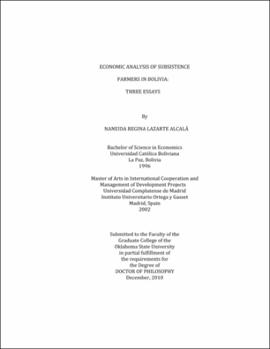| dc.contributor.advisor | Lahiri, Bidisha | |
| dc.contributor.advisor | Adkins, Lee | |
| dc.contributor.author | Lazarte Alcala, Naneida Regina | |
| dc.date.accessioned | 2013-11-26T08:23:34Z | |
| dc.date.available | 2013-11-26T08:23:34Z | |
| dc.date.issued | 2010-12 | |
| dc.identifier.uri | https://hdl.handle.net/11244/6718 | |
| dc.description.abstract | The first essay examines the role that remittances plays in income diversification strategies in the developing world. Using a large and nationally representative survey for Bolivia, we find that remittances alleviate production constraints and market failures that are commonly faced by rural farmers in agrarian economies. They represent an additional income source that relax credit constraints, and hence facilitate further diversification of rural households into other nonfarm activities. The results are based on an endogenous bivariate probit model where the probability of diversification is in part determined by the decision to remit. | |
| dc.description.abstract | The second essay demonstrates that the access to larger land endowments may not translate into income gains under conditions in which farmers may not have access to relevant rural markets, and hence are hypothesized to be confined to low (and even decreasing) marginal income values of land. Large farmers, on the contrary, freely access the market using their large land endowments and enjoy increasing marginal returns of the asset. A nationally representative survey data from Bolivia is primarily used to study the issue, and a semiparametric partially linear (PLR) regression model is applied to estimate the model's parameters. The results obtained confirm the derived marginal income effects of land for small farmers and large farmers, i.e. the relationship between land and wealth is nonlinear. The regional analysis carried out in this regard, ratifies the findings. Two estimation techniques were applied to verify the robustness of the results. | |
| dc.description.abstract | The third essay analyzes the impact of nonfarm income activities on the country's rural poverty and income inequality, using the MLE with a careful incorporation of exclusion restrictions that ensures the identification of the model. In order to differentiate the estimation among the three contrasting agroclimatic regions existing in the country, and the ones in which there are also coca leaves' cultivations, regional dummy variables are conveniently incorporated. The resulting consistent and efficient estimates from the sample selectivity model were used to predict a counterfactual income for rural households that diversify out from farm activities, as if they would be pure farmers. The paper concludes that nonfarm income in rural Bolivia has helped reduce the depth and severity of poverty, but the number of poor would have statistically remained the same. In terms of inequality there was no evidence of any significant effect. | |
| dc.format | application/pdf | |
| dc.language | en_US | |
| dc.rights | Copyright is held by the author who has granted the Oklahoma State University Library the non-exclusive right to share this material in its institutional repository. Contact Digital Library Services at lib-dls@okstate.edu or 405-744-9161 for the permission policy on the use, reproduction or distribution of this material. | |
| dc.title | Economic analysis of subsistence farmers in Bolivia: Three essays | |
| dc.contributor.committeeMember | Savvides, Andreas | |
| dc.contributor.committeeMember | Aime, Federico | |
| osu.filename | LazarteAlcal_okstate_0664D_11154.pdf | |
| osu.accesstype | Open Access | |
| dc.type.genre | Dissertation | |
| dc.type.material | Text | |
| dc.subject.keywords | inequality | |
| dc.subject.keywords | land | |
| dc.subject.keywords | migration | |
| dc.subject.keywords | non-farm income | |
| dc.subject.keywords | poverty | |
| dc.subject.keywords | rural | |
| thesis.degree.discipline | Economics and Legal Studies | |
| thesis.degree.grantor | Oklahoma State University | |
